Knife sharpening tools: types and rules of use
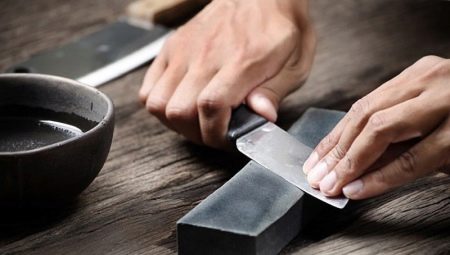
Knives are very useful tools that can come in handy in the household, creativity, or even in repair work. They have been used by man for a long time, and over time they have only been modified. But, like all good things, knives also have a disadvantage: they need to be sharpened from time to time, and today you will learn how to do it correctly.

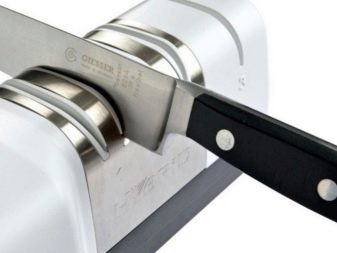
Varieties of devices
There are a huge number of possible options that can help in everyday life, at work, in a factory environment - wherever knives are used constantly. These objects can help in sharpening a varied nature, and each of them is good and convenient in its own way.
Grindstone
The oldest and most primitive knife sharpening devices are ordinary natural sharpening stones. However, today this method will not be the best; it can be used only for sharpening a hunting or kitchen knife. There are also other, more accurate options: water or "wet" Japanese stone - novaculite.
It is a little more convenient to use, but it still cannot be used for frequent and quick editing.

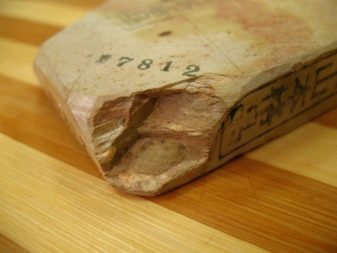
This stone must be used in combination with a special oil base. Of course, there are its domestic counterparts based on ceramics, however, the original would be the best choice. By the way, in the case of a Japanese sharpening stone, its flat surface is very important.You can check it like this: wet one side and attach it to a sheet of paper. If the print on the paper is perfectly even and evenly distributes the trace over the entire surface, then the tool is of high quality.
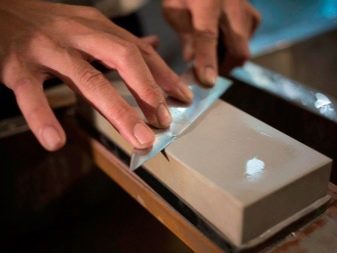

Sharpening stones are primitive ways to sharpen some kind of penknife for a trip to the forest, or to fix kitchen equipment every couple of monthsbut if you have something more serious, stones will not work for you.

Bars
There are other attachments that can help bring your tools back to their original condition, "like from the factory" - abrasive stones or whetstones. They differ in the coatings that are applied to them. If we talk about the differences between such bars, then there are quite a few of them.
- Sputtered with a diamond character - there are options for various shapes, and even sputtering grain. Despite the diamond spraying, their price is not very high, it can even be called democratic.
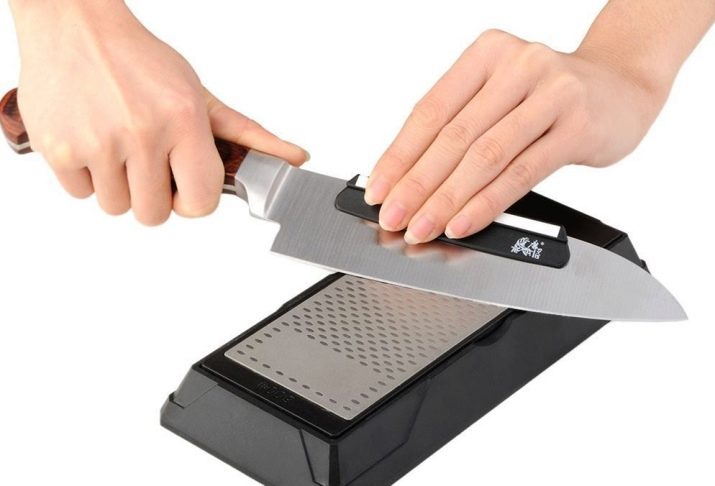
- Ceramic, combining the properties of a grinding stone and diamond dusting.

- Artificial stone - here the duration of use leaves much to be desired, but the prices for such stones are much lower. This option is created when mixing diamond powder with carbide, and both the ratio of substances and the adhesive are important there. Even this option may be of good quality, but it is still inferior to the alternatives.

When it comes to diamond dusting, there are two main ways to use and place it. Any of the layouts are called grit.
- A bunch called galvanic. This crystal arrangement is very strict. In this case, diamonds are glued in a thin layer over the entire surface of the base, which is most often created from a nickel alloy. It turns out a solid block.
- A soft location is characterized by chaos. In this design, it turns out that adhesives and diamond substances are mixed with each other and are located over the entire surface, but there is no clear structure in this mixture.
This option is not as durable as the first.

Venev diamonds are a unique name for the type of stones used in these kind of tools. They give the touchstone rigidity, which allows you to sharpen the knife quickly and well; if you handle it carelessly, there is a risk of even scratching the product.
There are also CBN bars made with cubic boron nitride. They are more expensive, but they work much softer, and are not a surface with separate sharpening elements, but a full-fledged working area, where each element of the structure is a working one.
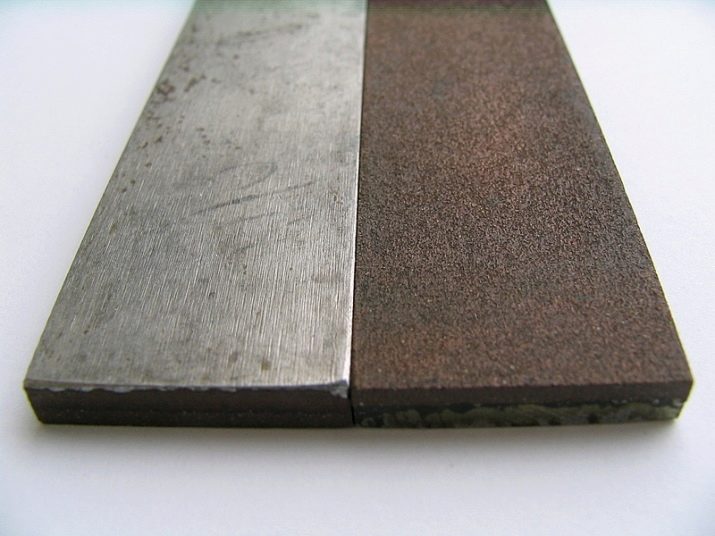
Musat
Musat - it is a knife sharpener made in the form of a stick or rather a file. This type of sharpening tool has several advantages. Musat is more comfortable to hold: it has a comfortable rubberized handle and looks more like a screwdriver than a classic whetstone. It can be stored among kitchen utensils, it is lightweight and will not cause damage even if dropped on the leg.
Musat can be either round or oval, but in any case, it is much more convenient to run the edge of the blade along such a "stick" than over a large, unwieldy stone.
For individual cases, you can use tetrahedral products, they allow you to more accurately select the sharpening angle, and more subtly create the shape of your knife.

Double-sided donkeys
They are often used to sharpen large knives that can be used to cut any sturdy material. The bar has a thick rectangular surface and a comfortable handle.

Manual machines
If you do not have the skill of turning knives correctly, and do not know for sure at what angle you need to hold the tool and carry out the movement, then a special device will do it for you. Such "machines" do not take up much space, and are a body that hides the insides, and a grinding disc on the side, made in the form of a ring. This shape helps him to distribute the working elements of the structure smoothly and evenly over the entire surface of the knife. The ring just spins at a sufficient speed, and that's it.
In order for the knife to become sharp, it is enough just to bring it in the correct position to the disc.On some models, there is even a special notch, which is located at the right angle, so that there is no chance of ruining the cutting tool.

What are the machine tools?
There are many units that will help you make a sharp knife out of a blunt knife correctly and without problems. They differ both in size and convenience, and in the variability of work. For example, you attach the device to a table, twist the knob that powers the disc, and set the knife at the right angle to the disc itself.
There are a huge number of solutions for any functionality, taste and wallet. Now you can buy various Russian-made hand-held machines.
A machine assembled at a factory in your home country will cost less and will be more than completely suitable for domestic needs.


Electric machines
Handheld devices are a fairly economical choice and will help you solve most of the problems you have with your tools. However, in the case of the electric option, you can save a lot of time and organize more comfortable work, from which you can even enjoy.
The models will be similar to manual, but electrically operated. The principle of operation is the same, but you don't have to turn any handle, just substitute the knife in the right place, and the device will do everything for you.

Moreover, there are special models that even operate on battery power. It is more advisable to use them when you are doing some difficult work with a knife. For example, you will need to sharpen several knives in a working day, and then it is much more convenient to simply insert them into a portable apparatus, and get the finished result in a matter of seconds.
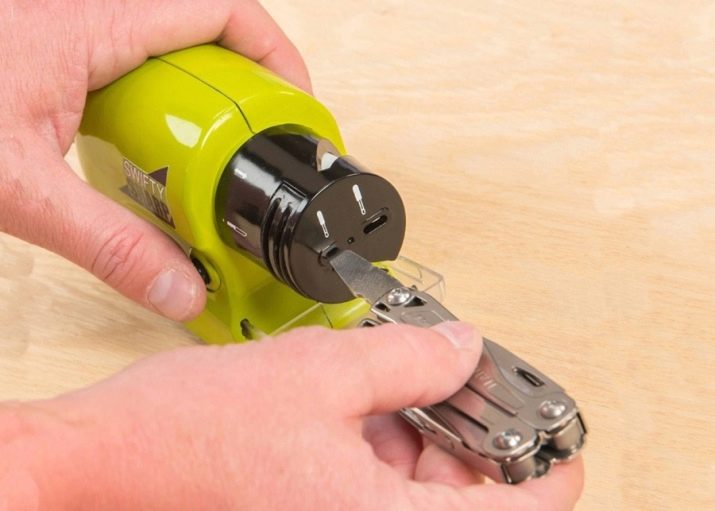
“From simple to more complex and professional” - this was the method used by manufacturers to create machines that are in themselves complete sharpening stations. Moreover, they are as versatile as possible, since they are suitable for working with absolutely any knives.
Such devices have at their disposal various powers and modes in which they can sharpen the blade. Everything is just as convenient: you simply insert the knife into a special hole, turn on the required stiffness for a specific metal, and run along the entire length of the knife until the result is completely satisfactory to you.
The security of this solution is at a high level, since any elements that can harm you are hidden inside and covered by the body, therefore any unprepared person will cope with the task.
In addition, the angle of all working areas has already been set correctly (and in some models it can also be adjusted), which means that it is almost impossible to make a mistake in this case.


Professional equipment
This type of tool is more suitable for craftsmen - people who use knives often and already have experience with a wide variety of designs.
If we talk about a hand-held machine, then it takes up quite a lot of space on the workbench, they usually assemble it on their own, which is precisely why it is characterized by unsurpassed accuracy. If a professional knows his business, has chosen the right elements, and perfectly accurately selected all the angles, then the accuracy of such a machine will not be equal.
It is worth warning unprepared people as the use of this equipment is not intended for inexperienced users.
If you just need to bring the kitchen utensils into a "digestible" state one time, then the easiest way to do this is using a simpler sharpener.

There are professional electric machines - this, when compared with the previous options, is already "aerobatics", however, even in using such a device, there is still nothing difficult. It has impressive dimensions, and the disc is quite wide and massive. Such pieces are used in locksmiths or at home, where there is a private house and farm.
The main advantage of this solution is its versatility. This is because such a device will help not only just sharpen a knife, but also bring into use almost any working tool made of metal.
The power of the device is more than enough, be it just kitchen utensils, a chisel, or even the edge of a bayonet shovel. On this machine, you can handle the ax without any problems.


Marking
There is a special type of sandpaper that does an excellent job of correcting a dull blade. Usually, a special mount is sold in hardware stores that you can comfortably hold in your hands while working. It is called a blank, and you can easily and comfortably attach any of the necessary sheets of sandpaper to it.
This option is very convenient for those people who very rarely meets with the use and tidying up of knives. In addition, this choice is characterized by its economy in comparison with any of the devices presented above. You can choose completely different paper, it is more or less rigid, works with different softness, and the form itself, and the sheet being purchased, has a wide variety of sizes.
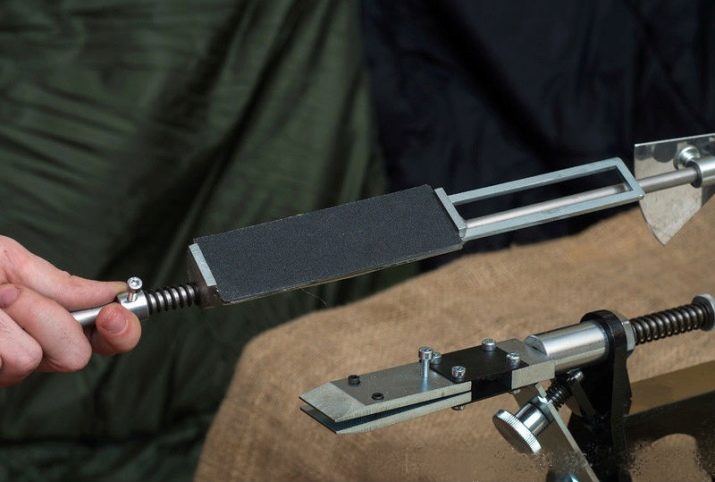
Marking is the name of the parameter that is responsible for the stiffness of the paper, more precisely, for the number of work items on a piece of paper. It can be 1000, 3000 and higher. The higher this parameter is, the more rigid the friction of the two surfaces will be.
You can buy sandpaper in whole sets and use them for all occasions. You don't have to change them too often, one piece is enough for you for several sharpenings.

What is the best choice?
If you are just thinking about purchasing any of the above options for home, work, etc., then it would be best to build on the needs and use plans.
A simple stone will lie with you for many years, and once you learn how to work with it correctly, improving the functionality of any knife from the kitchen or from a hunting bag will not be a big problem for you. If you are a fan of something special and more comfortable, you can use the Japanese natural solution, however, is less practical and more expensive.


For chefs and people who often use a variety of cutting tools, this is an excellent choice. comfortable and soft musat that can be used at least every time before cooking. This way you better prepare your utensils for work.

People who work with sharp objects every day are good at machine tools, the most convenient of which are electrical... Well, if your activity is completely tied to the use of garden utensils or devices for cutting wood, then feel free to take a large professional machine.

Subtleties of application
So that your tools make you happy, and the result does not make you want to redo anything, it is important to use all of the above.
To properly sharpen the knife with musat, it is enough to guide the working surface on the edge of the blade, not on the thinnest cutting surface. After all, the task is to make it thinner, and if we drive it over the musat, it will turn out that it will become even flatter and less sharp. If a wet stone is used, it must be lubricated. The instructions for use say more, but in general it is necessary to use an oil base for this.


The angle must also be chosen correctly. Household blades, as well as any kitchen utensil, tolerate a 30-degree angle. Performance varies from device to device, however, 25 to 30 will be sufficient in most cases.
By the way, machines must be trained before use: you must make sure that the structure is not damaged, that the electricity is supplied correctly, and the machine itself is firmly adhered to the working surface.

Common mistakes when sharpening
Untrained persons can make mistakes, and one of the main ones will be the use of a device with which you are not at all familiar and holding it in your hands for the first time.If you are a beginner, a regular musat or bar is best.
In addition, do not try to drive the sharpening surface along the blade itself - this will reduce its sharpness even more. Do not use professional machines if you need to sharpen a simple kitchen knife, and always choose the right angle at which you work.


For information on how to sharpen a knife on a stone correctly, see the next video.








